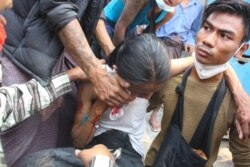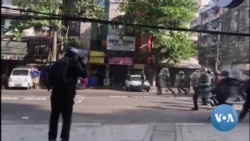As security forces in Myanmar respond with greater force against protesters, journalists are being targeted or caught in the crossfire.
The United Nations and the United States this week condemned the violent force used against citizens protesting a coup on February 1, with the U.N. estimating that the military and police have killed over 50 people.
In recent days, security forces have targeted the media. In some cases, they have used slingshots while arresting reporters, said Ye Naing Moe, a veteran journalist and founder of the Yangon Journalism School.
"These are police tactics to create fear among journalists deliberately," he told VOA Burmese. "On the other hand, young journalists are determined and courageous to continue doing their job. I am worried for them as police are targeting media obviously."
Police have also fired tear gas and rubber bullets to disperse protesters.
Photojournalist Htet Aung Khant, who was covering clashes in the city of Mandalay for VOA's Burmese Service, said he had been taking photographs of police and protesters for about 10 minutes on Wednesday when he felt a sensation in his side and realized he had been hit by a rubber bullet.
"I stepped back and asked people around me to check whether they see any blood," he said.
Medics helped clean his wounds, and he said he took a brief break before sending his images to VOA's offices in Washington and attempting to return to the protests.
"Later, I tried to go out and shoot video of the protest. However, my left arm hardly moves, and it was painful," Htet Aung Khant said.
The experience did not deter him.
"I am not afraid of doing my job," he said. "Today, I am covering the funeral of a girl whom police shot and killed on the spot during crackdown in Mandalay."
Protests have taken place in Mandalay and other cities and towns since Myanmar's military overthrew the civilian government and detained key opposition figures and members of the National League for Democracy (NLD) party.
Ye Naing Moe said he is concerned for reporters covering protests in smaller towns where they have fewer resources and can be easily traced.
The New York-based Committee to Protect Journalists (CPJ), which is documenting media arrests during the unrest, also expressed concern about safety in Myanmar.
"Journalists reporting on the anti-coup protests are also facing serious physical safety risks due to use of force by authorities," said Aliya Iftikhar, CPJ's senior Asia researcher.
Maria Salazar Ferro, CPJ's head of emergencies, told VOA the "single most important thing that journalists and newsrooms in any high-risk environment can do is to know the risk they face and think about how to mitigate that risk."
The U.S. State Department on Wednesday condemned the violence against civilians.
State Department spokesman Ned Price said he is "appalled and revulsed" by images of a crackdown on protesters, in which Myanmar security forces killed at least 38 people on Wednesday.
The U.S. has imposed sanctions on top military leaders in Myanmar.
Price said the U.S. is concerned by the arrests of journalists, including Thein Zaw from The Associated Press, who is charged along with five other reporters of violating Myanmar's public order laws.
"We call on the military to immediately release these individuals and to cease intimidation and harassment of the media and others unjustly detained merely for doing their jobs," Price said.
U.N. High Commissioner for Human Rights Michelle Bachelet said the military is ramping up arrests, with more than 1,700 arbitrarily detained in recent days, including at least 29 journalists.
"Myanmar's military must stop murdering and jailing protesters," Bachelet said in a statement.
VOA Acting Director Yolanda López also condemned the violence.
"Democracy depends on a free press and free flow of information," she said. "These incidents underscore, once again, threats journalists face daily around the world. VOA condemns these and other attacks that put the lives of our very brave journalists at risk and undermine a free press."
In addition to the risk of injury or arrest, CPJ's Iftikhar said Myanmar's citizens are being affected by sporadic shutdowns of the internet. Access to websites and social media is "crucial for citizens to have access to information and for reporters to be able to do their jobs," she said.
Jessica Blatt, Jessica Jerreat and Khin Soe Win from VOA's Burmese Service contributed to this report. Some information is from Reuters.













